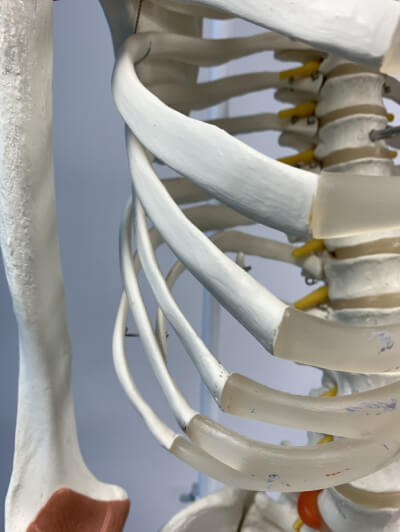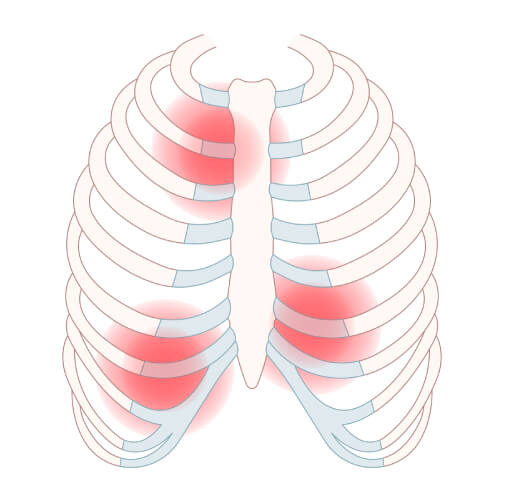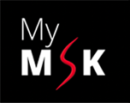
What is Slipped Rib Syndrome?
Slipped rib syndrome is a painful condition affecting the lower ribs in the chest. The ribs are bones that make up a frame/cage structure in order to protect the heart and lungs.
The ribs involved are ribs 8 to 10. These ribs (ribs 8-10) are often referred to as ‘false ribs’
It can go by other names such as ‘Clicking Rib’, ‘Chostochondritis’ or ‘Rib Subluxation’
The false ribs are not directly connected to the sternum. Instead they are attached to cartilage and fibrous tissue and ligaments which goes on to attach to the sternum (breastbone)
Slipped Rib Syndrome is still quite rare but can affect men and women of all ages. It accounts for approximately 5% of chest pain of a muscular origin seen by Clinicians (Gress et al 2020)
Why does this laxity/hypermobility occur?
Slipped Rib Syndrome often occurs due to hypermobility or laxity of the false ribs leading to slippage of the affected rib under the rib above it.
This movement can cause irritation of the intercostal nerve (these pass underneath the ribs) or intercostal muscles and a sharp pain and tenderness in this region.
Occasionally the bone of the affected rib may impact on the cartilage attached to it following a previous trauma and this also causes severe pain.
The pain comes from compressing the nerve that runs through the rib itself or pain from the degeneration this may bring in the bone/cartilage interface.
Genetics can play a part along with trauma to the ribs.
-
- Hypermobility: People who are Hypermobile are more likely to experience slipped rib syndrome. This is because the costal cartilages of the false ribs may be more mobile.
-
- Overuse (repeated twisting in certain occupation can cause an impact)
-
- Trauma: a fall or twist on the region may lead to scar tissue that causes pain thropugghout life (often a tender spiot on the rib is palpable and leads to pain)
It is interesting to note that a similar phenomenon in the first to seventh ribs – Chostochondritis.
What are the Symptoms of Slipped Rib Syndrome?
The presentation of slipped rib syndrome varies in each patient with pain being the primary symptom.

It is often an under-diagnosed condition as the symptoms of pain are vague, and can often be confused as to having Cardiovascular or Gastrointestinal source leafding to extensive investigations and false reassurance and anxiety.
The symptoms of slipped rib syndrome can include the following:
-
- Intermittent sharp stabbing pain – sudden in onset, provoked by sudden movements such as bending, twisting or sneezing.
-
- This is followed by a dull, aching pain in the same area for days to weeks. The pain can range from lower chest region to upper abdomen, as low as the umilical region.
-
- It can radiate to the front of the ribs or the back depending on movement and posture.
-
- Lying down can temporarily alleviate the pain due to a reduction in pressure in the area. Turning in bed however or lying on the affected area can make the pain worse
-
- It is usually unilateral (one sided) but can be bilateral as well.
-
- The patient may feel a clicking sensation – which is thought to occur in the lower chest region.
How is Slipped Rib Syndrome Diagnosed?
As mentioned earlier, this condition is highly under-diagnosed and patients might suffer with pain for years before it is correctly diagnosed.
Radiological investigations like CT, MRI and X-Ray often do not show any significant changes in the ribs.
Thus, diagnosis often comes from a very careful clinical examination and patient history
Patients will usually have a long history of pain. They will be asked if any movements worsen the pain such as twisting, coughing, lifting or bending down. Patients are also asked if they feel a popping sensation in the same region.
-
- Palpation: Palpating over the region can localise the pain. Often there is focused tenderness around the costal margin or muscles between the ribs (Intercostal muscles)
-
- Hook Manouevre: The clinician hooks their finger under the lower ribs and pulls them outward. (A Painful click may be felt during this examination)
The above 2 tests are often diagnostic.
Further testing can be done by the Dynamic ultrasound technique where the patient is asked to perform the actions that elicit pain, such as coughing or turning etc.
The ultrasound allows the rib movements to be observed in real time and is advantageous compared to CT/MRI/XRAY where the patient is still.
The test is positive when the ribs can be seen moving upwards during certain movements.
How is Slipped Rib Syndrome Treated?
The focus of treatment is to control inflammation and pain, which is initially done through:
-
- Rest
-
- Decreased activity
-
- Topical or Oral anti-inflammatory drugs (NSAIDs) such as ibuprofen or naproxen
-
- Applying ice or heat over the affected area
-
- Physical therapy
In cases where symptoms are still not managed or improving:
-
- Local injections of corticosteroids to reduce pain and swelling. These are often mixed with an anaesthetic to as a nerve block for the intercostal nerves reducing pain: This procedure is referred to as an Intercostal Nerve Block and is performed under Ultrasound guidance for safety
-
- Taping of ribs to try and provide temporary relief and minimise movement
Clinically, it has been observed that these methods help the majority of patients with the pain of Slipped Rib Syndrome
However, in cases where the symptoms persist despite these methods, the long term solution is correcting the anatomy through surgery called ‘costal cartilage excision’.
The procedure aims to remove the costal cartilage and its covering to prevent regrowth of cartilage. This provides permanent relief to patients with minimal complications but is a last resort.
Knowledge and awareness of Slipped Rib Syndrome is important for clinicians as it can prevent years of undiagnosis, disability and pain. Once diagnosed, there are several treatment modalities that can be tried to help the patient.
If you have symptoms of Slipped Rib Syndrome you can Simply Click here to book an assessment with us, or call us at 0333 772 9655, and let us help you live a better and healthy life.
